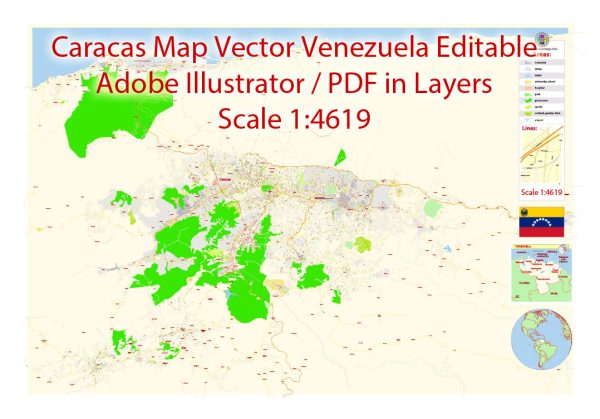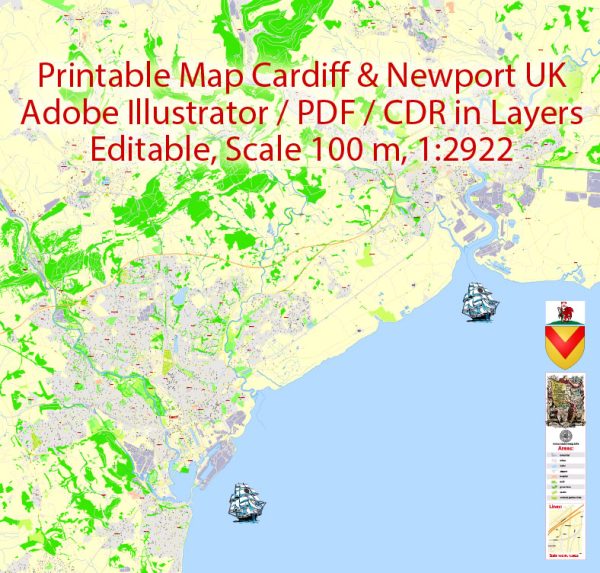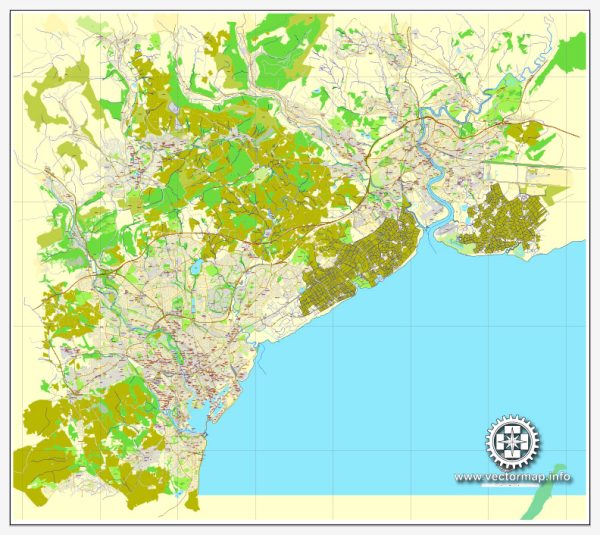Caracas, Venezuela, calle vectorial imprimible mapa Plan de la ciudad, lleno, Adobe Illustrator editable, vector completo, y editables, nombres de calles de formato de texto, escalables, 3,8 mb ZIP
Todas las calles, algunos edificios más. Mapa de diseño, impresión, artes, proyectos, presentaciones, para los arquitectos, diseñadores y constructores.
PDF, DXF, DWG, CDR y otros formatos – a petición, el mismo precio, por favor, póngase en contacto
Caracas, Venezuela, printable vector street City Plan map, full editable, Adobe illustrator, full vector, scalable, editable, text format street names, 3,8 mb ZIP
All streets, some more buildings. Map for design, print, arts, projects, presentations,
for architects, designers and builders.
PDF, DXF, DWG, CDR and other formats – on request, same price, please, contact
Caracas, Venezuela.
This vector map of Caracas is used as a basis for design, editing, and further printing.
This is the most detailed, exact map of Caracas for high-quality printing and polygraphy. You can always clarify the map development date by contacting us.
For your convenience, all objects on Caracas vector map are divided into layers. And the editing is very easy – colors, lines, etc.
You can easily add any objects needed (e.g. shops, salons, sale points, gas station or attraction) on any layer of Caracas vector map.
Caracas is the capital and largest city of Venezuela, and centre of the Greater Caracas Area. Caracas is located along the Guaire River in the northern part of the country, following the contours of the narrow Caracas Valley on the Venezuelan coastal mountain range (Cordillera de la Costa). Terrain suitable for building lies between 760 and 1,140 m (2,490 and 3,740 ft) above sea level, although there is some settlement above this range. The valley is close to the Caribbean Sea, separated from the coast by a steep 2,200-metre-high (7,200 ft) mountain range, Cerro El Ávila; to the south there are more hills and mountains. The Metropolitan Region of Caracas has an estimated population of 7,267,102.
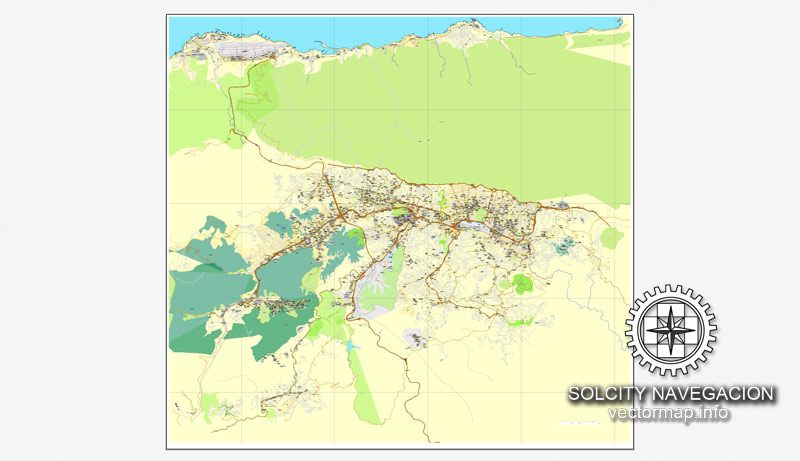
One of the advantages of Caracas vector maps of our production is the relevance of cartographic data, we constantly update all our products.
This vector map of Caracas is used by:
designers, layout designers, printers, advertisers and architects. Our product – vector maps – is designed for further editing and printing in large formats – from @Wall format (a few meters) to A-0 and A-1, A-2, A-3.
Caracas map in vector format is used for design, urban planning, presentations and media visualizations.
Advertising and presentation map of Caracas (usually the final designer marks the routes, and puts the client’s objects (shops, saloons, gas stations etc.)
The undoubted advantage is that people will NEVER throw out this advertising product – the map. In fact, as an advertising medium, a map is the most “long-playing” of the well-known polygraphic advertising media, with the longest lifespan, and the maximum number of interactions with the customer.
For travelers, maps are sold at the airports and gas stations around the world. Often the source is our vector maps.
Take a look, who purchases our vector maps of Caracas in “Our Clients and Friends” page – these are large and small companies, from super-brands like Volvo and Starbucks, to small design studios and printing houses.
It’s very easy to work with vector maps of Caracas, even for a not very experienced designer who can turn on and off the map layers, add new objects, change the colors of fill and lines according to customer requirements.
The undoubted advantage of Caracas vector maps in printing is an excellent and detailed visualization, when customer can expand a large paper map and instantly define his location, find a landmark, an object or address on map, unlike using the popular electronic formats of Google and Yandex maps for example.
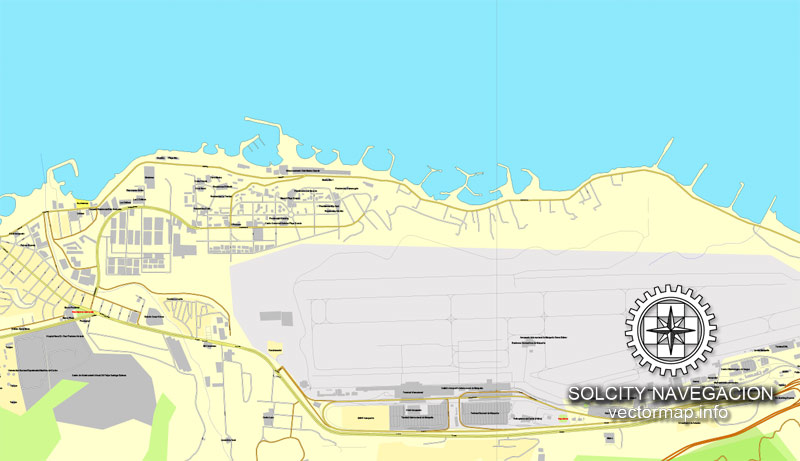
Printable vector maps of Caracas are much more convenient and efficient than any electronic maps on your smartphone, because ALL DETAILS are displayed in the entire space of Caracas map.
Useful tips on working with vector maps of cities and countries in Adobe Illustrator.
«V» – launches the Selection tool (cursor, black arrow), which makes active any vector line.
«А» – launches the Direct Selection tool (white cursor), allows you to select curve elements and drag them to the desired place.
«R» – activates the Rotate tool, which helps you rotating selected objects around the center point by 360 degrees.
«E» – gives you the opportunity to use the Eraser tool and erase unnecessary parts.
«X» – switches between Fill and Stroke in the Tools section. Try to get used to this hot key and
you will quickly understand that you can’t live and work without it.
Guides are not limited to vertical and horizontal in Adobe Illustrator. You can also create a diagonal guide for example. Moreover, you can turn any contours into guides. Select the outline and go to View > Guides > Make Guides (Create Guides), or simply press Cmd/Ctrl + 5. You can also turn the guides back into an editable object. Go to menu, View > Guides > Unlock Guides (Release Guides), select the guide you want to edit and select View > Guides > Release Guides (Reset Guides), or just press Cmd/Ctrl + Option / Alt + 5).
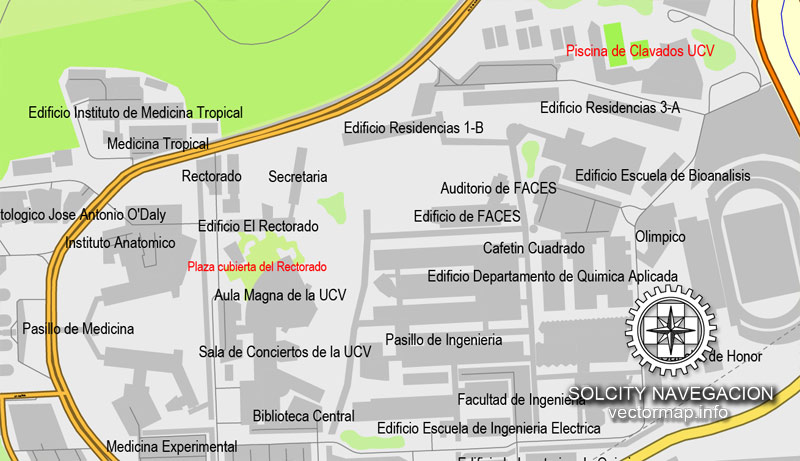
You will probably want to change the color scheme used on our Caracas vector map.
To quickly and effectively play with colors.
Of course, you can do it manually, all objects in our Caracas vector map are divided according to types and layers, and you can easily change the color gamma of vector objects in groups and layers.
But there is more effective way of working with the whole VECTOR MAP of Caracas and all layers:
The overview dialog «Edit colors»/«Repaint Graphic Object» (this dialog box name can change depending on the context):
If you have selected a part or a layer of Caracas vector map and open the dialog box by clicking the icon in the Control panel, on the Samples palette or the Color Catalog, or if you choose Edit > Edit Colors> Repaint Graphic Object, then the «Repaint Graphic Object» dialog box appears, and you get access to «Assign» and «Edit» tabs.
If a picture or a map fragment is not selected, and you open the dialog box by clicking the icon in the Control panel, on the Samples palette or in the Color Catalog, the «Edit Colors» dialog box appears and you can only access the «Edit» tab.
Regardless of the name at the top of the dialog box, the right-hand side always displays the color group of the current document, as well as two default color groups: Print Color and Grayscale. These color groups can be selected and used any time.
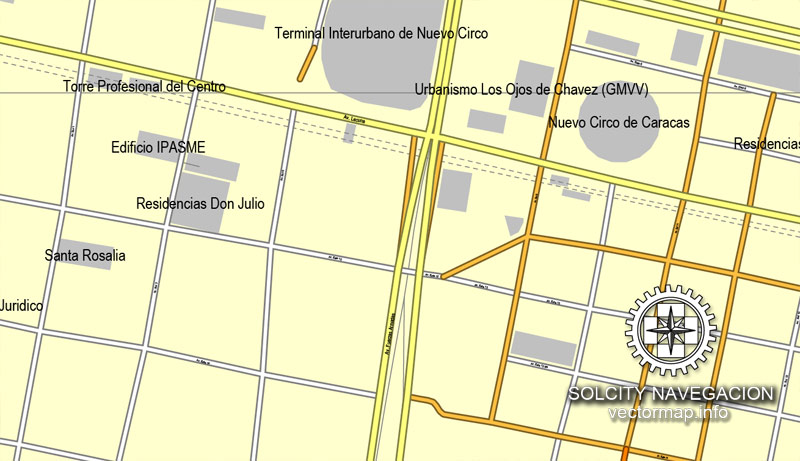
Create and edit color groups of Caracas vector map, and also assign colors using the «Edit Colors»/ а «Repaint Graphic Object» dialog box.
A. Creating and editing of a color group on the «Edit» tab
B. Assigning colors on the «Assign» tab
C. Select a group of colors from the «Color groups» list
The option «Repaint a graphic object» in the lower part of the dialog box allows you to preview the colors on a selected layer of Vector map, or a group of elements, and specify whether its colors will be redefined when the dialog box is closed.
The main areas of the dialog box are:
«Edit»
The «Edit» tab is designed to create a new or edit the existing color groups.
The harmony rules Menu and the Color Wheel are used to conduct experiments with color harmonies. The color wheel shows how colors are related in color harmony, and the color bars allow you to view and manipulate an individual color values. In addition, you can adjust the brightness, add and remove colors, save color groups and view colors on the selected Vector Map of Caracas or a separated layers.
«Assign»
The «Assign» tab is used to view and control on how the original colors are replaced with colors from the color group like your corporate colors in the Vector Map of Caracas.
The assign color ability is provided only if the entire map, layer or fragment is selected in the document. You can specify which of new colors replace the current colors, whether the spot colors should be preserved and how colors are replaced (for example, you can replace colors completely or changing the color tone while maintaining the brightness). The «Assign» tab allows you to redefine colors in the Vector Map of Caracas, or in separate layers and fragments using the current color group or reducing the number of colors in the current Vector Map.
Color groups
Is a list of all saved color groups for current document (the same groups appear in the «Samples» palette). You can edit and delete the existing color groups, as well as creating a new ones using the list of “Color Groups” in the dialog box. All changes appear in the «Samples» palette.
The highlighted color group shows, which color group is currently edited.
Any color group can be selected and edited, or used to redefine the colors in the selected vector map of Caracas, its fragments or elements.
Saving a color group adds this group to the specified list.
Opening the «Edit Colors»/«Repaint Graphic Object» dialog box.
Open the «Edit Colors»/«Repaint Graphic Object» dialog box using one of the following methods:
«Edit»> «Edit Colors»> «Repaint Graphic object» or «Repaint With Style».
Use these commands if you need to edit the colors in the selected vector map of Caracas.
«Repaint Graphic object» button on the «Control» panel.
Use this button if you need to adjust colors of Caracas vector map using the а «Repaint graphic object» dialog box.
The specified button is available if the selected vector map or its fragment contains two or more colors.
Strictly speaking, the centre of the city is still “Catedral”, located near Bolívar Square, even though it is assumed that it is Plaza Venezuela, located in Los Caobos neighbourhood and extends along the Boulevard of Sabana Grande to the east. Chacaíto area, Luis Brión Square and El Rosal neighborhood are also considered the geographic center of the Metropolitan Region of Caracas, commonly called “Greater Caracas”. The political-administrative division of Caracas has not yet been updated, but the project has been discussed several times.
Note. This color editing method is convenient for global color adjustment in a vector map, if global colors were not used when creating a Map of Caracas.
The «Edit colors» button or «Edit or apply colors» on the «Color Catalog» palette
Click this button if you need to edit colors on the «Color Catalog» palette or edit and then apply them to the selected Vector Map of Caracas or its fragment.
The «Edit color group» button or «Edit or apply color group» on the «Samples» palette.
Click this button if you need to edit the colors in the specific color group or edit and apply them to the selected Vector Map of Caracas or a group of its elements, for example, the whole layer “Streets and lines”. You can also double-click the color group in the Samples panel to open the dialog box.
If the map file is too large and your computer freezes or even can’t open it quickly:
1. Try to reduce the color resolution of the video card (display) to 256 colors while working with a large map.
2. Using Windows Task Manager, select all the application you don’t need, while working with map, just turn them off.
3. Launch Adobe Illustrator. (DO NOT OPEN the vector map file)
4. Start the Windows Task Manager using administrator rights > Find the “Illustrator” process > set the «real time» priority,
5. Open the file. When you see the LEGACY FONT popup window – click “OK” (do not update). You can restore the TEXT later.
6. Can also be useful: When file is opened – Edit > Settings > Basic Settings > disable smoothing. /// It looks scary, but works quickly)))
We recommend saving the file in Adobe Illustrator 10 version. It’s much more stable when working with VERY BIG size files.
Businesses in the city include service companies, banks, and malls. Caracas has a largely service-based economy, apart from some industrial activity in its metropolitan area. The Caracas Stock Exchange and Petróleos de Venezuela (PDVSA) are headquartered in Caracas. PDVSA is the largest company in Venezuela. Caracas is also Venezuela’s cultural capital, with many restaurants, theaters, museums, and shopping centers. Some of the tallest skyscrapers in Latin America are located in Caracas.
Caracas has been considered one of the most important cultural, tourist, industrial and economic centers of Latin America. The Museum of Contemporary Art of Caracas is one of the most important in South America. The Museum of Fine Arts and the National Art Gallery of Caracas are also noteworthy. The National Art Gallery is projected to be the largest museum in Latin America, according to its architect Carlos Gómez De Llarena. Boulevard of Sabana Grande is the main commercial corridor of the city and is visited by more than 500 thousand people every day. In 2011, the pedestrian space of Sabana Grande quadrupled. Sabana Grande is a broad, tree-shaded, pedestrians-only boulevard lined on both sides with stylish fashion boutiques, gift shops and street art.
Caracas is home to two of the tallest skyscrapers in South America: the Parque Central Towers. It has a nominal GDP of 91988 million dollars, a nominal GDP per capita of 18,992 and a PPP GDP per capita of 32,710 dollars. Being the seventh city in GDP and the seventh metropolitan area in population of Latin America. The Parque Central Towers still boast the title of the highest twin towers in Latin America, even though they are no longer the tallest skyscrapers in the region. In Caracas, the tallest skyscrapers are: Parque Central Towers, Banco Mercantil Building, BBVA Provincial Tower and The Twin Towers of El Recreo Shopping Mall in Sabana Grande district. Most of these buildings are located in the center of the city. Unfortunately, Business Center Confinanzas was not completed. If so, it would be the third tallest skyscraper of Caracas.
According to some sources, Caracas has the second highest per capita murder rate in the world, with 111.19 homicides per 100,000 inhabitants. Others have argued that the number of homicides in Venezuela has been inflated. Most murders and other violent crimes apparently go unsolved.
Geography
Caracas is contained entirely within a valley of the Venezuelan central range, and separated from the Caribbean coast by a roughly 15 kilometres (9 miles) expanse of El Ávila National Park. The valley is relatively small and quite irregular, the altitude with respect to sea level varies from between 870 and 1,043 meters (2,854 and 3,422 ft)
, with 900 meters (3,000 feet) in the historic zone. This, along with the rapid population growth, has profoundly influenced the urban development of the city. The most elevated point of the Capital District, wherein the city is located, is the Pico El Ávila, which rises to 2,159 meters (7,083 feet). The main body of water in Caracas is the Guaire River, which flows across the city and empties into the Tuy River, which is also fed by the El Valle and San Pedro rivers, in addition to numerous streams which descend from El Ávila. The La Mariposa and Camatagua reservoirs provide water to the city. The city is occasionally subject to earthquakes – notably in 1641 and 1967.
Small guide: How to work with the vector map?
You can: Mass select objects by type and color – for example, the objects type “building” (they are usually dark gray) – and remove them from the map, if you do not need them in your print or design project. You can also easily change the thickness of lines (streets), just bulk selection the road by the line color.
The streets are separated by type, for example, type “residential road” are usually white with a gray stroke. Highway usually orange with a brown or dark gray stroke.
It is easy to change the font of inscriptions, all or each individually. Also, just can be make and any other manipulation of objects on the vector map in Adobe illustrator format.
Important: All the proportions on the map are true, that is, the relative sizes of the objects are true, because Map is based on an accurate GPS projection, and It transated into the (usual for all) the Mercator projection.
You can easily change the color, stroke and fill of any object on the map, zoom without loss of quality Image Verification.
Select object

Bulk selection the same objects on the vector map

See the bulk selected objects on the vector map

Bulk delete buildungs from the vector map

Select residencial road (small street) on the vector map

Bulk selection the same lines (streets, roads) on the full map

Create fat lines of the streets on the vector maps (bulk action) 1

Create fat lines of the streets on the vector maps (bulk action) 2

Create fat lines of the streets on the vector maps (bulk action) 3

You can easily change the color, stroke and fill of any object on the map, zoom without loss of quality Image Verification.
Tips/Tricks/Tutorials & News about vector maps.
Download Google Map Maker Vector Data Mapperz, a great maps and GIS blog, this week spotted that Google are allowing developers to download the vector data for Kenya maps made in Map Maker.
It is possible to download the data in either Keyhole Markup Language (KML) or in ESRI Shapefile format. The data is available here for non-commercial use.
Mapperz has downloaded the files and has been playing around with the data in ArcMap and Google Earth. You can see the results on the Mapperz blog.
The Brain Off blog has also been discussing this new developemnt from Google Maps and looking at the possible consequences for Open Street Map and Open Geo Data.
Source.
Need more Vector maps clipart? Visit our catalog countries and cities maps.




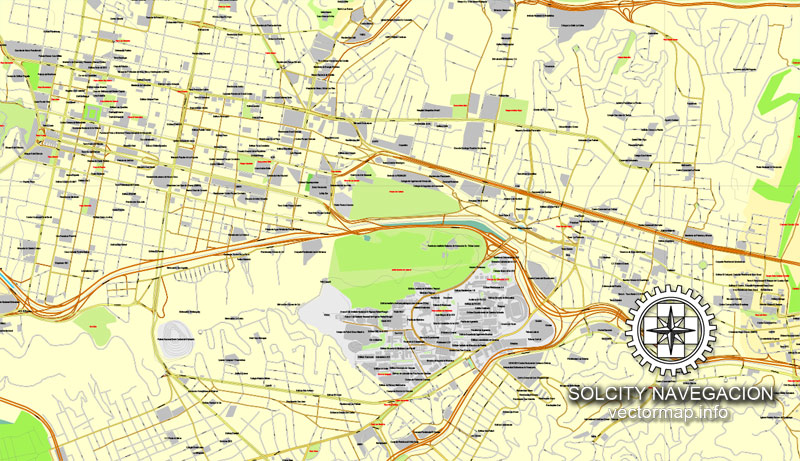











 Author: Kirill Shrayber, Ph.D.
Author: Kirill Shrayber, Ph.D.